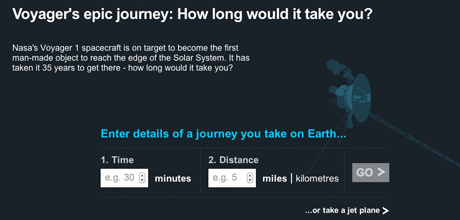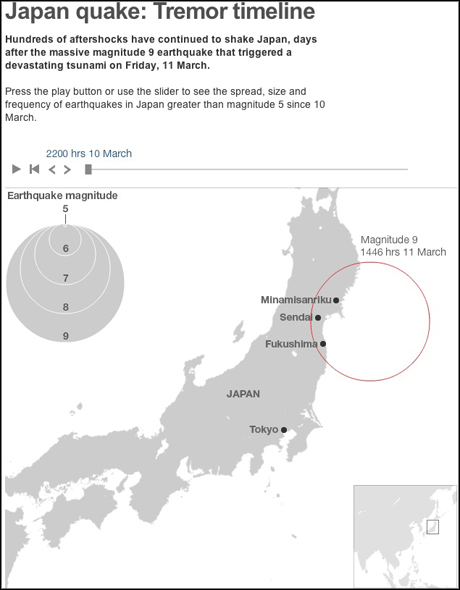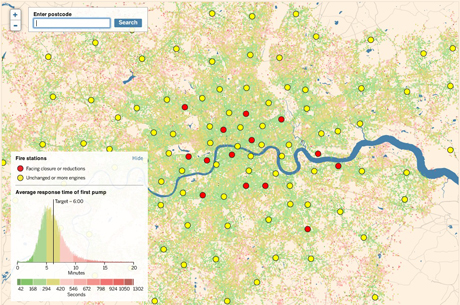
This is an edited version of a chapter from Data Journalism: Mapping the Future, being launched tomorrow by Abramis academic publishing, republished with kind permission.
Data journalism: Mapping the future (RRP £15.95) is available at a reduced rate of £12 for Journalism.co.uk readers. Contact richard@abramis.co.uk for further information.
"Why all your students must be programmers" was the provocative title of one of the liveliest panel discussions at the August 2013 Conference for the Association for Education in Journalism and Mass Communication in Washington DC. On Twitter, it was dubbed the #AEJMCBattleRoyale (Hernandez 2013).
The panellists talked passionately about how their programming skills enabled them to take their journalism to a whole new level – interrogating data to find the stories nobody else could or turning static, text- based web pages into dynamic, interactive tools.
There was less agreement about what level of "programming" knowledge is actually useful to a journalist. There was even less agreement about how to teach it to students in an already tightly- packed course schedule. What do you throw out?
In the United States, the idea of the journo-coder, programmer-journalist, hacker-journalist, journo-programmer (the terminology is undecided) is gaining ground as data journalism develops and the possibility for interactivity on news websites expands every year. Programmers are coming into newsrooms and journalists are venturing further into programming and there is some blurring where the two meet.
A small number of academic studies have tracked the rise of this phenomenon in American newsrooms. For example, Cindy Royal conducted a case study of "Journalists as programmers" in The New York Times’s Interactive News Technology Department, suggesting guidelines for other news organisations to follow (Royal 2010). Sylvain Parasie and Eric Dagiral’s study focuses specifically on the city of Chicago and suggests that bringing programmers into the newsroom challenges some journalistic ideals (Parasie and Dagiral 2012).
But here in the UK, much less has been written about the "journo-coder" and whether he/she even exists although there are some excellent short case studies in the Data Journalism Handbook (Gray, Chambers and Bounegru 2012).
This chapter is, therefore, an exploratory look at how newsrooms here are bringing together these two professions to produce different kinds of data- driven, interactive journalism. Is the goal to create hybrid journo-coders who can write great stories one day and build a website the next? Or is it to nurture teams of "tech-savvy journalists and news-savvy technologists?" (Leimdorfer cited in Herrmann 2011).
Through a series of interviews with journalists and developers working at the BBC and Financial Times plus some key players outside of major newsrooms, this chapter aims to find out how journalists and developers are working together. The way technology is adopted in newsrooms is shaped not by the technology itself but by existing organisational structures, work practices and how the end- user is perceived (Boczkowski 2004b).
So this chapter also looks briefly at how their work is incorporated into the newsroom structure. Perhaps more importantly from an educational point of view, it examines which technical skills journalists need now and in the future. Must all journalism students be programmers?
The product
The BBC’s Visual Journalism team creates a range of data-driven features for the BBC News website. It consists of a team of journalists, developers and web and television graphics designers which carries out complex data projects and produces visualisations, maps and interactive features.

The fuel price calculator is a typical example. The user types in their own details and compares the price for fuel with the price around the world. The developers worked with the journalists to turn all the different data sets on global fuel prices into an interactive feature. At the same time, the designer on the project visualised the information in a way that encourages the user to engage, play and share.
Not all the Visual Journalism team’s output relies on crunching data sets. The news that Nasa’s Voyager 1 spacecraft may be about to leave the Solar System led to the creation of an interactive journey timeline to convey the vast distances of space. The user is invited to input details of a familiar journey – duration and distance.

The tool then uses that small piece of data to calculate how long it would take the user to complete each stage of Voyager’s journey past the planets. Each stage is illustrated with key quotations and historic footage to create an interactive, multimedia experience. As Andrew Leimdorfer, the technical product manager in the Visual Journalism team, explains: "We could have put all of this in a standard news story and laid it out differently. But the added design finesse makes it a nicer experience for the user."
Two to three weeks is the usual timescale for the team’s projects although that is getting stretched now that the audience is fragmented across different platforms. So creating new, bespoke interactive features like this for breaking news is tricky. The team is more likely to use existing tools for a breaking news story and then innovate online with a background feature a few days after a big story initially breaks. For example, following the Japan earthquake of March 2011, the team used data from the US Geological Survey to put together a dynamic map which shows the frequency and size of aftershocks.

The Interactive News team at the Financial Times is similar in that it brings together journalists, developers and designers to combine multimedia, interactivity and data visualisation. For example, the interactive map in Figure 4 uses data obtained from Freedom of Information requests showing the London Fire Brigade’s response times.

One of the most innovative digital journalism projects to date at the Financial Times has been the Austerity Audit – a dynamic piece of storytelling which combines multimedia, data visualisation and long-form text. “The stuff we do is quite flashy and involves a lot of coder time,” says Martin Stabe, the head of interactive news at the Financial Times.

Much of that coder time is concentrated on the "front-end" – building the interface that creates the user experience, the interactivity. That involves HTML (the structure of the webpage), CSS (the style of the webpage) and crucially JavaScript which builds the interactivity and manipulation. So where does the journalist fit into this team? Do they need to acquire coding skills? Do the programmers need to acquire journalism skills?
Hybrid or specialist?
Only one of the respondents interviewed at the BBC and Financial Times was comfortable being described as a journo-coder or any of the other hybrid job descriptions. "I’d like to think that any developer that works on any journalism team is a journalist," said one. Another respondent identified himself as a programmer but felt he was "becoming more journo". However, he didn’t feel he would ever be a complete journalist.
All other respondents identified themselves strongly as either a journalist or a developer. They were sceptical about the possibility of combining both skill-sets in one person. Typical statements include:
"I’ve never met a journalist who is particularly adept at coding in my fairly limited pool."
"I just say I’m a journalist who specialises in maps and charts."
"I don’t think a person can straddle both. To make an interactive requires so many different areas of knowledge, you need years of experience just doing that. And journalism is a whole other area of expertise so you’d be lacking in focus on one side."
Andrew Leimdorfer, at the BBC, says that journo-coder hybrids are not essential on his team as long as there are highly talented specialists who can work together. Martin Stabe, at the Financial Times, does not believe truly hybrid journo-coders currently exist in the UK. Instead, both news organisations have adopted a team approach, bringing together journalists, developers and designers.
The dream team – and the importance of technical skills
All the respondents at the BBC and Financial Times who identified as developers were highly proficient in HTML, CSS and JavaScript and tended to see these as their most important skills. Other key skills included "back-end" programming languages such as PHP and Python which can be used, for example, to access databases. Additionally, they described data and statistical skills to analyse and organise large datasets such as SQL, SPSS and R.
Although Martin Stabe insists that the team approach is the only way to create the "journo-coder", he also believes that for a team like that to work, you need journalists who can at least understand what is technically possible...
"...who can write just enough code to understand what the developers are doing, who can do good data management and the data sourcing aspect of the interactive, investigative project."
Journalists in these teams are not involved in front-end programming and describe their expertise in using software rather than creating it through coding. Analysing information rather than developing interactivity is the key technical skill. One respondent described his skills in "simple things" such as Excel or using mapping software such as ArcMAP.
When asked which technical skills journalists should have in an ideal world, all respondents emphasised analysing and cleaning up data and a good knowledge of statistics. For Andrew Leimdorfer, the aspiration for journalists should be to be as technically self-sufficient as possible.
"If a person who discovers an interesting data-set then scrapes it from the website, cleans it up to make it usable and visualises it using an online technology – then they are going to be in a much stronger position going to an editor to pitch a story based on that data than someone who found a data-set but has to pitch for a developer’s time to try and do something with it. You can see how the first guy would be in a much better position."
This is an important point which was emphasised repeatedly. In a newsroom, developers are a rare and precious resource. So the more basic coding skills a journalist can perform, the more time the developers can spend on the highly specialised tasks. For example, Martin Stabe believes it is reasonable to expect journalists to be able to write simple programming scripts which scrape data from the web and store it on a database.
"From a full-time developer’s point of view, these are fairly trivial, simple tasks they wouldn’t mention on their CV. If you asked a top-notch developer what their skill set is, they probably wouldn’t mention they could write complex Excel functions or that they can manage a database using SQL or write a really simple scraper in Python. For a journalist those are exceptional skills and definitely accessible skills and skills that an increasing number of journalists have."
Learning the skills
The respondents came from a variety of backgrounds with only two having degrees in computer-oriented subjects. The rest had gained their knowledge through a variety of informal, self-directed means.
"Basically, it’s asking people around you. It saves time. If you try to literally teach yourself, that’s very time-consuming. People are often very willing to help.
"I’ve learnt so much from fellow colleagues – how to build code that is robust and can scale without breaking."
A major part of learning comes from tapping into the community of developers and journalists working in similar areas either online or through informal meet-ups where knowledge is shared.
"There’s a huge online community of programmers so you need to absorb yourself in that. You can go to GitHub, download someone else’s code and read how they did it. That’s the best way to learn - reading the code and seeing how somebody else made it. Otherwise, people blog about how they made something so you keep abreast of what people in similar roles are doing through Twitter.
"Often the best training is not from software manufacturers but from journalists using the software."
Knowledge-sharing and the need to continually learn is a distinguishing feature of the developer community and one which it is bringing in to newsrooms to problem-solve on each new project. All respondents said they were constantly learning new skills and pushing the boundaries of their knowledge. In fact, the developers interviewed consistently said 20 to 25 per cent of their work time was spent learning.
"You learn by always coding at the edge of your understanding ... It’s about constantly throwing yourself into a slightly uncomfortable situation then learning your way out of it."
"Every year there’s a different way of doing things, producing graphic or interactive, so you have to constantly look at what you know about how to do your job."
However, for the developers, there was no requirement to learn the traditional journalism skills. Instead, they talk about “absorbing” a better understanding of journalistic storytelling.
"I have a better instinct now for what journalists need, what the reader wants to see. But I think the roles are split quite nicely ... There’s a huge amount I don’t need to know – law, editorial guidelines, style. I just don’t get involved in that kind of thing."
Working together
Although journalists and developers have their own specialist knowledge and expertise, they need to understand each other’s requirements. Andrew Leimdorfer describes his team constantly "bouncing bits of knowledge off each other" and developing a shared language. Journalists on his team, he says, are very different from traditional newsroom journalists.Although journalists and developers have their own specialist knowledge and expertise, they need to understand each other’s requirementsLiz Hannaford
"They’re the interface. They understand what the UX (User Experience) guys and developers do. They’re web natives. But there is still specialisation. Similarly a developer coming in from outside, it’s a tremendous culture shift for them, sitting with journalists. But they quickly adopt the newsroom lingo. What’s the top line? What’s the peg?"
Ideas very often come from outside the interactive teams, from specialist news desks who need a complex, data-driven story told in a compelling way. But ideas also come from journalists within the team.
The journalist’s first job is to find the data and analyse it to see if it says anything newsworthy. The journalist might then try out some simple visualisations to better understand the data and think about how they might want to tell the story. Having established that the story merits valuable developer time, the process becomes highly collaborative with journalist, developer and designer working closely together.
"The developer is not a deli counter and the reporter doesn’t just come up and order what sandwich they want.
"It’s not something where one person’s job starts therefore another person’s job stops ... That collaboration continues right till you’ve finished."
The journalist takes on a project management role, overseeing the process right through to completion. This means understanding the problem from the developer’s point of view, accepting what can and cannot be achieved in the timescale, discussing technical trade-offs and making sure they get the user experience they want for their story.
Coding for fun
So why do journalists choose to work in this highly technical area? And what draws developers to a newsroom? For the journalists, the attraction is the constantly changing nature of the challenge and the ever-expanding possibilities for storytelling. So the interest comes from having to always re-frame the way they do things. They are also excited by the power of numbers to reveal a story.
"I got into this broadly through election coverage and being interested in the numbers coming out of opinion polls. They were a really good way to see what was going on and so different from how politicians talk.
When the developers were asked to explain why they wanted to work in a newsroom with a bunch of journalists, the word that came up repeatedly was "fun". Typical responses include:
"When I leave the office, I have a sense of satisfaction. I’ve done something good. Whatever I’ve worked on, quite a lot of people are going to benefit from it.
"Because it’s a bit unconventional, firstly. It’s a very dynamic environment ... I’ve worked on all kinds of applications that aren’t that interesting in terms of what they actually do but the technical side is interesting. In the newsroom, the content of the thing we’re making is interesting to me."
"The newsroom is a very good fit for my style ... I’m not a good enough developer to do things that impress other developers. I know just enough to make whatever it is I want to make in the way an ordinary audience would appreciate it."
"The immediacy is a real challenge – making stuff people are going to get something from instantly and will deepen their understanding."
So, the tight deadlines of a newsroom are part of the appeal. For developers, it is like being on a permanent Hackday, constantly building quick prototypes with like-minded people. But they also talked about the creativity of coding in a newsroom.For developers, it is like being on a permanent Hackday, constantly building quick prototypes with like-minded peopleLiz Hannaford
"It’s a very creative process, coding, and there’s a big non-technical space – working with people, understanding their problems and solving their problems through building systems.
"We as developers, we do things because they excite us ... I might be playing around with a dataset ... to find out 'I wonder what I can actually do with this data. I wonder how I can make this display on a page ... in a way I haven’t seen done before. ...It’s more about fun'."
Beyond the mainstream
So far this chapter has looked at how journalists and coders are working together as a team in mainstream newsrooms. But at the fringes of media production, the idea of the hybrid journo-coder is much more attractive.
Away from large news organisations, specialisation is a luxury few can afford, says Sarah Marshall, former technology editor at Journalism.co.uk, and now social media editor, EMEA, at the Wall Street Journal. She estimates there are fewer than twenty people in the UK whom she would describe as "journo- coders” but believes their numbers are on the increase.
"Actually, a lot of us in newsrooms are working by ourselves so learning skills is really helpful. For those who really skill up, there are clear advantages."
Benji Lanyado is one example of a journalist who has "skilled up" and has no hesitation in describing himself as a "journo-developer". He started out as a travel writer at the Guardian, then left to learn how to code. At the end of his first programming course, he created the Reddit Edit, a snapshot of what’s trending on Reddit. He also creates interactive stories for news organisations as a freelancer.
"The reason they say [journo-coders can’t exist] is because that’s the reality right now. There are very few journalists who code and very few developers who can write good copy or edit a story or oversee an editorial product ... I guarantee that the journalists of the future will be more code proficient."
That’s certainly the mantra at the London chapter of HacksHackers – a global grassroots network of informal meet-ups stretching from Buenos Aires to Johannesburg. It brings together journalists (the hacks), developers (the hackers) and all sorts of geeky permutations in between. Most don’t describe themselves using traditional job titles. Instead words like "creative", "interactive", "storytelling", "multimedia", "data analysis", "entrepreneurship" crop up time and again.
What brings them to a converted brewery in East London is a belief that technologists and journalists belong together and, just sometimes, can exist within the same person. HacksHackersLondon, founded by Joanna Geary, previously at the Guardian, now at Twitter, started out as a small gathering in a pub for a few journalists who wanted to learn to code and a few developers who were happy to teach them. It has evolved into a monthly meet-up that has outgrown the pub and regularly packs well over a hundred people into a room.
The conversation is all about the intersection of technology and storytelling and the need to be a part of that. Journalists discuss ways to upgrade their digital skills and look for developers they can learn from. One attendee describes how she was forced to reassess her dream of becoming a journalist when she saw the traditional industry shrinking. Now she’s working hard to develop new skills in interactive media, data and programming believing these are the skills that journalism needs today.
It’s about networking and collaboration, finding like-minded people who can work together across disciplines on investigative projects. These are the people Sarah Marshall, who co-organises HacksHackersLondon, believes will blur the line between journalist and programmer in the future.
"A bit of every journalist wants to be a developer and a lot of developers want to be journalists."
Conclusion - Ditch shorthand and learn to code?
There seems little doubt that an understanding of programming is an increasingly useful skill in the journalist’s toolkit and one which is valued in the newsroom. It was interesting to note that in July 2013, the advertisement for the Guardian’s Digital Journalism Scheme included “coding” on its list of selection criteria. (Guardian 2013).
An "understanding" of programming obviously covers a broad spectrum. It is unlikely that journalists could also acquire the expertise to write production code for a global news brand whose website is put under huge scrutiny. That is likely to remain the preserve of experienced developers. But the journalists working with these developers need to know enough programming to understand what is possible within the constraints of budgets and timescales.
But a journalist looking to work on a B2B or a hyperlocal website where a team of developers is an unaffordable luxury may well find that a reasonable confidence with HTML, CSS and JavaScript is attainable and would be a highly desirable item on their CV. This is where there could be a real area of opportunity for student journalists looking to find a niche in an era when traditional newsroom jobs for graduates are becoming rarer.
How should journalism departments at our universities respond? Should they ditch shorthand and teach code instead?! Certainly, this is happening to some extent in the States. Columbia Journalism School offers a dual MSc in Computer Science and Journalism.
The Medill School of Journalism at NorthWestern University offers scholarships to students with computer science backgrounds to study on its Masters programme. Here in the UK, the launch of the Interactive Journalism MA at London’s City University in 2011 has done much to increase the number of people with these highly technical skills.We need to foster the curiosity that drives people to constantly seek new knowledge and expand their skills, always thinking about where journalism is going rather than where it has beenLiz Hannaford
Obviously, you do not need to be able to program in order to be a great journalist. But learning some coding skills opens up so many exciting opportunities. It is about creating intellectual curiosity, learning outside your comfort zone. Yes, full-on programming can be daunting but students can dip their toe in the water, at least, by scraping a bit of data off a website into a spreadsheet.
That can often produce the fist-pumping moment of achievement that gets them hooked. They’ve taken the first step on the road to programming. Universities could try to create a HacksHackers-type environment that brings journalists and technologists together and encourages them to collaborate across disciplines to see where it takes them.
Most importantly, we need to foster the curiosity that drives people to constantly seek new knowledge and expand their skills, always thinking about where journalism is going rather than where it has been. All journalists of the future are going to be working on a digital product. They need to be at least curious about how things work behind the scenes.
Liz Hannaford teaches journalism at the University of Salford.
Free daily newsletter
If you like our news and feature articles, you can sign up to receive our free daily (Mon-Fri) email newsletter (mobile friendly).









